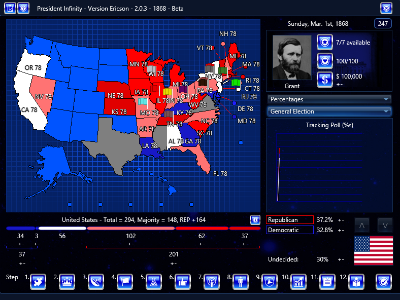Version 2.0 (w/ events added by Davis Os)
*This scenario has been greatly updated by the Historical Scenario Commission on July 27, 2017. You can download version 3.0 here: United States – 1868 v. 3.0
This election takes place three years following the Civil War and the assassination of Abraham Lincoln. The two major issues are the radical Republican brand of Reconstruction, which was a departure of Abraham Lincoln’s planned lenient Reconstruction, and the second major issue is charges of abuse of power against incumbent President Andrew Johnson.
For Republicans, the nomination was unanimous for victorious Union General Ulysses S. Grant, who had just recently declared that he was a Republican. Salmon P. Chase and Benjamin Wade, both of Ohio, had considered a run for the presidency, but dropped out when Grant jumped in. They couldn’t hope to compete with the leading living Northern hero of the Civil War.
For the Democrats, the party tried to show support for Andrew Johnson while also scrounging for a more competent replacement for him. Former Ohio Representative George H. Pendleton was the leading front-runner, with Thomas Hendricks, General Winfield Scott Hancock, incumbent President Andrew Johnson, and many others also in the race. However, a dark horse compromise candidate, who would have probably been the front-runner if he actively campaigned, was popular former New York governor Horatio Seymour.
No third parties are ON for this election.
This election allows for many what-if scenarios:
- What if Salmon P. Chase and Benjamin Wade had stayed in the race to compete against Grant?
- What if several other leading Republicans joined the race, such as William Seward, Roscoe Conkling, Simon Cameron, Charles Sumner, John C. Fremont and many more.
- What if Abraham Lincoln had not been assassinated and ran for a 3rd term? Shot at the height of his achievements, would he have retained his popularity against a Radical Republican congress that vehemently opposed his lenient Reconstruction. Could he keep on the campaign while rapidly ailing to what some historians think was Marfan’s Syndrome?
- What if several other notable Democrats ran for the nomination? These include, 1864 nominee George B. McClellan, former president Franklin Pierce, John Quincy Adams II and others.
- What if the Constitutional Union party reemerged to find a middle ground for Americans. Former president Millard Fillmore leads this what-if 3rd party.

